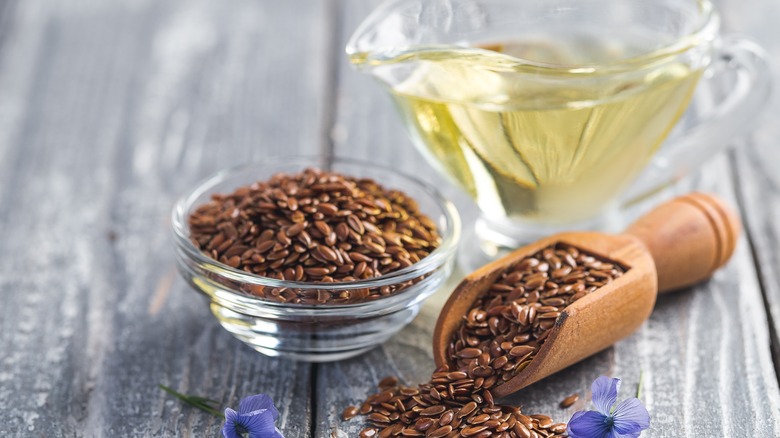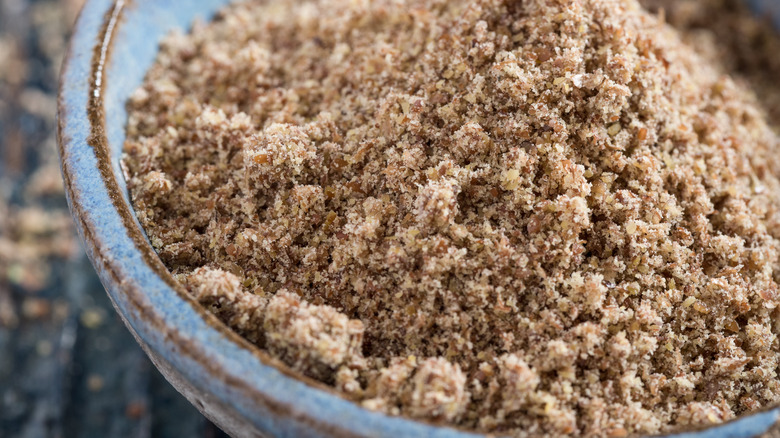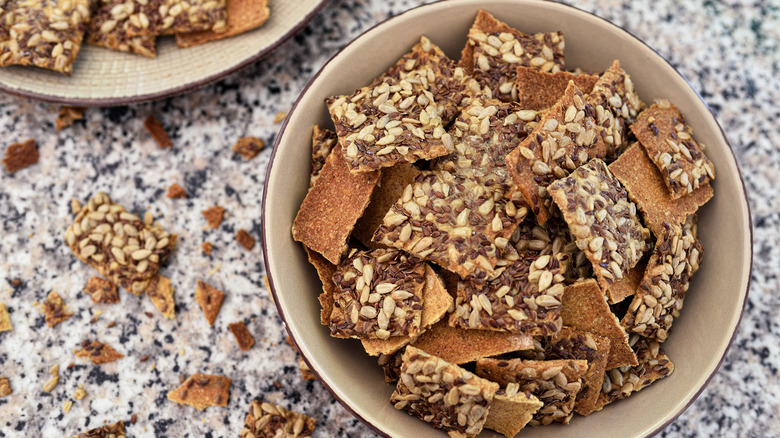How To Eat Flaxseeds And The Best Way To Grind Them
Tiny, smooth, grain-like flaxseeds pack a serious nutritional punch, but you have to know how to tap into their potential. Linum usitatissimum, more commonly known as flaxseeds, flax, or linseed, is a flowering plant with two primary varieties — one is grown for its fibrous stalks that are used to make fabrics, lace, linen, thread, twine, and canvas while the other is cultivated for its seeds which can be consumed directly or pressed into oil. Linseed usually refers to resulting oils and meals that are not intended for human consumption, but there are also food-grade varieties — this terminology can vary.
You can absolutely eat flaxseeds whole, but they are difficult to digest. Unless you chew them up meticulously, most of the seeds will pass through your system without releasing their benefits. Breaking open the flaxseeds by blitzing them in a coffee or spice grinder, chopping them with a sharp knife, or grinding them in a mortar and pestle will increase the bioavailability of the nutrients. You can even grind flax seeds in a high-powered blender. Alternatively, you can buy pre-ground flaxseed meals at many supermarkets and health food stores.
If you prefer the look or texture of whole flaxseeds, soak them in water for a few hours to break down the outermost seed coating and make them easier to digest. Soaked whole flaxseeds or flaxseed meal mixed with water will yield a gelatinous texture — this also makes flaxseeds one of the best egg substitutes and a great, nutrient-dense, thickening agent.
What kinds of flaxseeds can you buy?
Whole flaxseeds come in brown and golden varieties. Nutritionally speaking, the two types are almost exactly the same except that brown flaxseeds contain more alpha-linolenic acid. Brown flaxseeds have a deep, toasted, nutty flavor while golden flaxseeds are mild, buttery, and lightly sweet. You can shop for either brown or golden varieties of both flaxseed meal and oil.
Store-bought or homemade flaxseed meals make fantastic additions to baked goods, smoothies, porridges, crackers, breads, batters, and juices. Try combining flaxseed meal with yogurt, milk, chia seeds, and oats for amped-up overnight oatmeal. Flaxseed oil does have a low smoke point so it's best not to use it for high-heat sauteeing, but its nutty taste is perfect for salad dressings and drizzling. Try using a blend of flaxseed oil, apple cider vinegar, mustard, and brown sugar to dress roasted root vegetables.
Ground flaxseeds spoil quickly, so only grind what you intend to use quickly, and store any leftovers or an opened bag of store-bought meal in the refrigerator. When stored properly, flaxseed meal can last several months but can spoil within a few weeks if left at room temperature. Whole seeds can last up to two years when stored in an airtight container in a cool, dark place, or in the refrigerator. Flaxseed oil goes bad easily and is definitely an oil that fares better in the fridge. Spoiled flaxseeds will have a chemical, rancid, or sour odor.
What nutrients do flaxseeds have?
If you were to grind and eat just a one tablespoon serving of whole flaxseeds, you would be consuming nearly three grams of fiber and two grams of protein, notes Healthline. The high fiber content is great for digestion regularity. It is always important to drink plenty of water when consuming flaxseeds as with any other fiber-dense foods, and consuming too much can cause mild digestive discomfort.
Flaxseeds are rich in alpha-linolenic acid — the same omega-3 fatty acid that chia seeds are known for — and lignans, both of which may improve heart health, help prevent cancer, reduce inflammation, and regulate blood pressure. Flaxseeds are also rich in minerals like magnesium, phosphorus, calcium, and thiamine. Flaxseed oil does not contain the protein and fiber that the whole seeds do, but it does contain those same fatty acids in an easily digestible form. Given the numerous health benefits, flaxseeds definitely hold their own among other superfoods.



